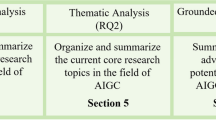Abstract
There is growing recognition of the importance of patient education given the prevalence and consequences of low health literacy in Canada and the USA. Research has shown that in addition to plain language, the use of theories of learning can contribute to the effectiveness of patient education resources, and as such, various guidelines and toolkits have been put together to help healthcare providers utilize these theories. Despite these efforts, this knowledge is not consistently applied in practice. To address this gap, we describe a new theory-based protocol, the “3Ws and an H,” that is designed to guide healthcare providers in the production of effective patient education resources. Adult learning theory underpins each step of the process, and by using the “3Ws and an H,” relevant theories are applied as the steps of the protocol are followed. To facilitate the adoption of this process, we describe it using a resource development project for survivors of endometrial cancer as an example.

Similar content being viewed by others
References
Canadian council on Learning (2008) Health literacy in Canada: a healthy understanding
U.S. Department of Health and Human Services (2010) Healthy people 2020: health communication and health information technology. Washington, DC
Canadian Council on Learning (2007) Patient self-management: health-literacy skills required, in lessons in learning
Berkman N et al (2011) Health literacy interventions and outcomes: an updated systematic review, in evidence report/technology assessment. Agency for Healthcare Research and Quality
Canadian Council on Learning. and Canadian Electronic Library (Firm), Health literacy in Canada: a healthy understanding, 2008, 2008, Canadian Council on Learning: [S.l.]
Davis TC et al (2002) Health literacy and cancer communication. CA Cancer J Clin 52(3):134–149
Doak CC et al (1998) Improving comprehension for cancer patients with low literacy skills: strategies for clinicians. CA Cancer J Clin 48(3):151–162
Tabak N (1995) Decision making in consenting to experimental cancer therapy. Cancer Nurs 18(2):89–96
DeWalt DA, Callahan L, Hawk VH, Broucksou KA, Hink A, Rudd R, Brach C Health Literacy Universal Precautions Toolkit, Agency for Healthcare Research and Quality: Prepared by North Carolina Network Consortium, The Cecil G. Sheps Center for Health Services Research, The University of North Carolina at Chapel Hill, under Contract No. HHSA290200710014
Institute of Medicine (2003) Priority areas for national action: transforming health care quality. The National Press, Washington, DC
Brach C, Debra K, Hernandez LM, Baur C, Parker R, Dreyer B, Schyve P, Lemerise AJ, Shcillinger D (2012) Ten attributes of health literate organizations. Institute of Medicine
Knowles MS, Holton EF, Swanson RA (2011) The adult learner : the definitive classic in adult education and human resource development, 7th edn. Elsevier, Butterworth-Heinemann, Amsterdam; Boston, xii, 406 p
Cross S (2009) Adult teaching and learning: developing your practice. McGraw-Hill Education
National Institutes of Health (2009) (CPEN), C.P.E.N., A survey tool for cancer patient educator competencies
Boswell EJ et al (1990) Training health care professionals to enhance their patient teaching skills. J Nurs Staff Dev 6(5):233–239
Frenk J et al (2010) Health professionals for a new century: transforming education to strengthen health systems in an interdependent world. Lancet 376(9756):1923–1958
Services LL (2002) How adults learn: connecting with your audience. Ottawa, Canada
Miller GA (1956) The magical number seven plus or minus two: some limits on our capacity for processing information. Psychol Rev 63(2):81–97
Lorig K (2001) Patient education: a practical approach. SAGE Publications
Doak CC, Doak LG, Root JH (1996) Teaching patients with low literacy skills. Lippincott Williams & Wilkins
Magneson VA (1983) A review of findings from learning and memory retention studies. Innovation Abstracts. 5(N25)
Bersin J (2004) The blended learning book: best practices, proven methodologies, and lessons learned. Pfeiffer, San Francisco, California
Fleming ND (2001) Teaching and learning styles: VARK strategies. Honolulu Community College, Honolulu
Doak CC, Doak LG, Root JH (1985) Teaching patients with low literacy skills. Lippincott, Philadelphia, xix, 171 p
Cassidy S (2004) Learning styles: an overview of theories, models, and measures. Educ Psychol 24(4)
Author information
Authors and Affiliations
Corresponding author
Additional information
Christine (Tina) Papadakos and Janet Papadakos are first co-authors and have equal contribution in this paper.
Rights and permissions
About this article
Cite this article
Papadakos, C., Papadakos, J., Catton, P. et al. From Theory to Pamphlet: The 3Ws and an H Process for the Development of Meaningful Patient Education Resources. J Canc Educ 29, 304–310 (2014). https://doi.org/10.1007/s13187-013-0600-z
Published:
Issue Date:
DOI: https://doi.org/10.1007/s13187-013-0600-z




